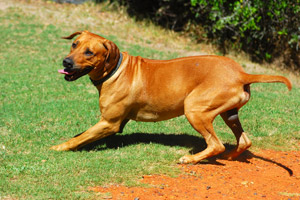
Before you purchase a new dog, there are several things you must consider beyond what you are going to name him and what color sweater will look most darling on him. One of the most important elements to owning a dog is providing him with sufficient exercise and allowing him outdoor space and time.
Dog Run Basics
Most dogs require a minimum of two outside trips a day to do their business and to sniff around. If you want to give your dog more outdoor time, but are concerned about your pet digging up the garden or escaping the yard, you can build a dog run.
- Definition. A dog run is an enclosed area of space where a dog can stay without a leash. It is usually gated and locked so that other animals cannot enter and your dog cannot escape. Dog runs can be made in any shape and can have customized properties. Some runs are used strictly as zones for exercise, while others are intended for extended use, even overnight. You can attach your dog run to a kennel to give your pup even more outdoor space.
- Size. The bigger your dog, the bigger the run. The more room you are able to give your dog, no matter what his size, the better.
- Shape. The dog run can be any shape that suits your yard. I think the best dog runs are those, however, with a long stretch. Try to arrange the run so that the dog can work up his speed to sprint back and forth without running into the fence. A square run is fine if your yard will not allow a thinner, longer, style run. A longer run will allow the dog to “cover more ground”, so to speak–which means more smells and other interesting things to look at for your dog. Dogs are happiest when they can play outside, doing a variety of activities.
- Location. The dog run is designed to provide your pooch with a place to hang outside the house. Make sure the dog run is convenient to your house so you can keep an eye on your animal. Keep the run away from your garden if you are concerned about heavy traffic on your plants or grass.
- Essentials. Always have a water dish, and
 make sure you keep the run clean. The dog run should be big enough so that the dog can “attend to his business” without a sanitary issue raising. Keep on top of clean up for a happy pooch, and, likely, happy neighbors. Oh, and keep some toys handy in there for Fido as well. It will keep him entertained while he is relaxing in his run. And make sure his activities don’t bother neighbors.
make sure you keep the run clean. The dog run should be big enough so that the dog can “attend to his business” without a sanitary issue raising. Keep on top of clean up for a happy pooch, and, likely, happy neighbors. Oh, and keep some toys handy in there for Fido as well. It will keep him entertained while he is relaxing in his run. And make sure his activities don’t bother neighbors. - Extras. Some owners outfit their dog runs with all the bells and whistles. Owners will adorn the run with a tarp to keep the sun off the dog, while others build doghouses that go inside the run. Think about whether you need a ground cover, and what kind of dog run designs will fit your property best. If you live in an extreme weather climate or if your dog has specific weather-related conditions, be sure to make special arrangements. You might want pet doors to the house, a wider enclosed dog kennel area, or to leave bowls of water and food out.
How To Build Your Dog Run
The following steps should be followed for the actual construction of the run.
- Clear the area. Rake or shovel the area of the dog run before you measure and mark.
- Measure. Before you get any tools out, you will need to measure and mark the perimeter of your dog run. Consider the size, shape, and location tips above. Use a tape measure and stakes to mark out the corners.
- Dig. Dig two foot deep holes for your fence posts (if it is a typical 5 foot tall fence).
- Concrete the posts. Set your fence posts with concrete. Be sure you have them where you want them prior to cementing, since afterwards you can’t move them.
- Keep your dog from digging. Lay chicken wire along the perimeter of the fence line. This will inhibit your dog from digging below the fence. Use wire cutters and tent stakes to hold the chicken wire down.
- Fence time. Once the posts are set, run chain-link fencing from post to post. Use fence ties and pliers to twist the ends of the fencing together to form a solid corner. Hang the gate.
- Masonry. Line the edge of your fence with bricks or brick-sized stones. These will weigh down the chicken wire, enhance the aesthetic quality of your dog run, and support the gate and fencing.
- Cover it. Get some wood chips, mulch, or gravel to cover the remaining exposed chicken wire. Gravel is not highly recommended since it can hurt some dogs’ feet. Wood chips are the preferred material to use for this final step. This covering agent will further keep your dog from digging under the fence to freedom.
- Check it. Do a perimeter walk (inside and outside) and make sure no chicken wire is exposed, no fence ends are untied (dangerous to humans and animals), and that the fence is secure all around the run. Make sure the gate is hung to specifications, and that it cannot be opened without using the latch (i.e. your dog cannot simply push it open). You may want to add a lock to make the run more secure.
Once you have your dog run and you are confident that it is stable and secure, adorn it with your pooch’s favorite items and let him loose in his new play area.
